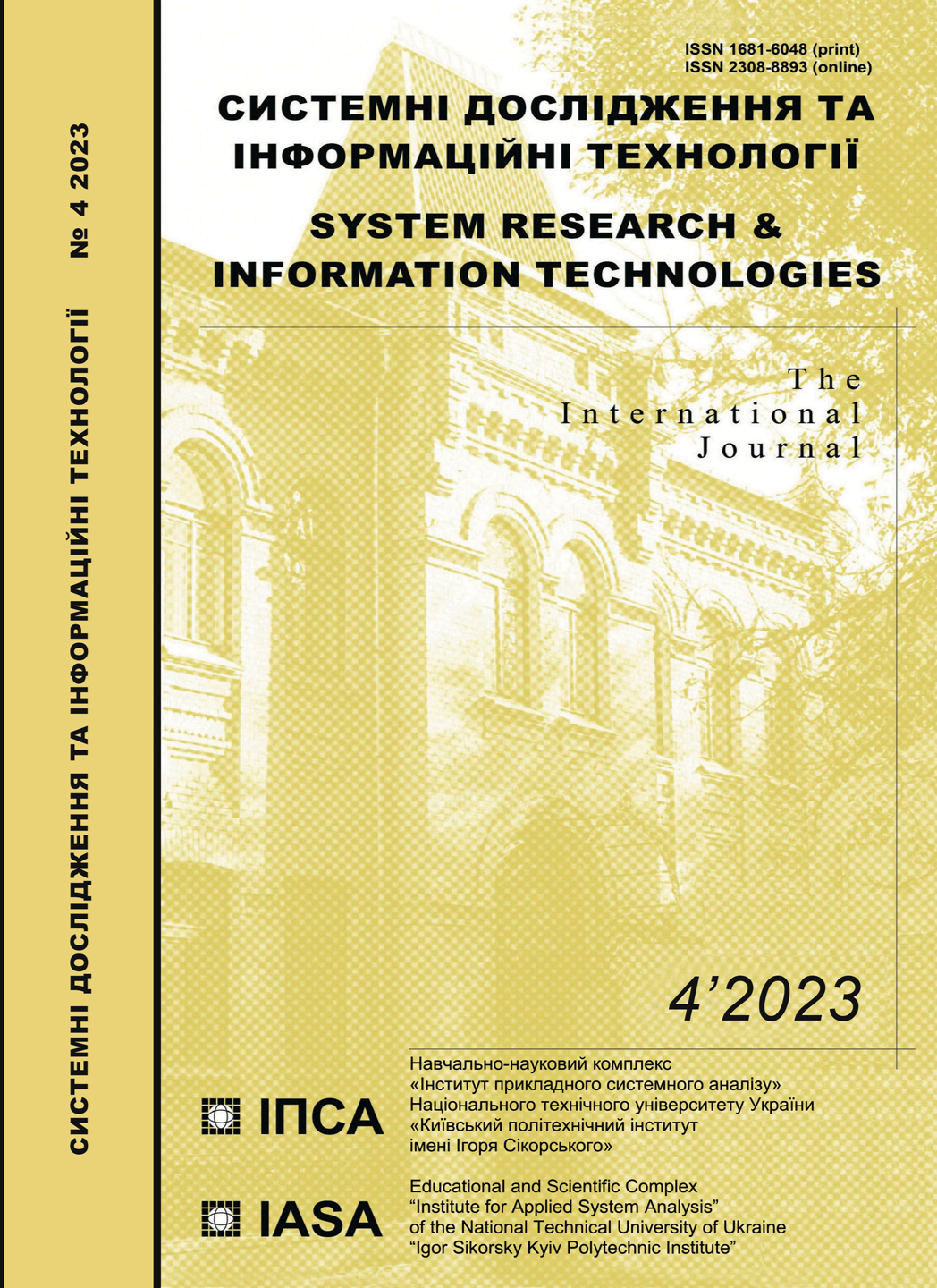Novel modified kernel fuzzy c-means algorithm used for cotton leaf spot detection
DOI:
https://doi.org/10.20535/SRIT.2308-8893.2023.4.07Keywords:
Cluster Accuracy Rate (CAR), Clustering, Cotton Leaf Disease, Fuzzy Clustering Method (FCM), Kernel Fuzzy C-means Algorithm (KFCM), Novel Modified Kernel Fuzzy C-Means Clustering Algorithm (NMKFCM)Abstract
Image segmentation is a significant and difficult subject that is a prerequisite for both basic image analysis and sophisticated picture interpretation. In image analysis, picture segmentation is crucial. Several different applications, including those related to medicine, facial identification, Cotton disease diagnosis, and map object detection, benefit from image segmentation. In order to segment images, the clustering approach is used. The two types of clustering algorithms are Crisp and Fuzzy. Crisp clustering is superior to fuzzy clustering. Fuzzy clustering uses the well-known FCM approach to enhance the results of picture segmentation. KFCM technique for image segmentation can be utilized to overcome FCM’s shortcomings in noisy and nonlinear separable images. In the KFCM approach, the Gaussian kernel function transforms high-dimensional, nonlinearly separable data into linearly separable data before applying FCM to the data. KFCM is enhancing noisy picture segmentation results. KFCM increases the accuracy rate but ignores neighboring pixels. The Modified Kernel Fuzzy C-Means approach is employed to get over this problem. The NMKFCM approach enhances picture segmentation results by including neighboring pixel information into the objective function. This suggested technique is used to find “blackarm” spots on cotton leaves. A fungal leaf disease called “blackarm” leaf spot results in brown leaves with purple borders. The bacterium can harm cotton plants, causing angular leaf blotches that range in color from red to brown.
References
P.M. Paithane and S.N. Kakarwal, “Automatic determination number of cluster for multi kernel NMKFCM algorithm on image segmentation,” in International Conference on Intelligent Systems Design and Applications, pp. 870–879. Springer, Cham, 2018.
Chun-Yan Yu, Ying Li, Ai-lian Liu, and Jing-hong Liu, “A novel modified kernel fuzzy c- means Clustering algorithms on Image segmentation,” 2011 14th IEEE International Conference. doi: 10.1109/CSE.2011.109.
Saiful Islam and Dr. Majidul Ahmed, “Implementation of Image Segmentation for Natural Images using Clustering Methods,” IJETAE, vol. 3, issue 3, March 2013.
L.A. Zadeh, “Fuzzy Sets”, Information and Control, 8, pp. 338–353, 1965.
Songcan Chan and Daoqiang Zhang, “Robust Image Segmentation Using FCM With Spatial Constraints Based on New Kernel Induced Distance Measure,” IEEE transactions on Systems, MAN and Cybernetics-Part B: Cybernetics, vol. 34, no. 4, August 2004.
P.M. Paithane, S.N. Kakarwal and D.V. Kurmude, “Automatic Seeded Region Growing with Level Set Technique Used for Segmentation of Pancreas,” in International Conference on Soft Computing and Pattern Recognition, pp. 374–382. Springer, Cham, 2020.
P.M. Paithane and S.N. Kakarwal, “Automatic Pancreas Segmentation using A Novel Modified Semantic Deep Learning Bottom-Up Approach,” International Journal of Intelligent Systems and Applications in Engineering, 10(1), pp. 98–104, 2022.
Pradip Mukundrao Paithane, “Yoga Posture Detection Using Machine Learning,” Artificial Intelligence in Information and Communication Technologies, Healthcare and Education: A Roadmap Ahead, 2022.
S. Kakarwal and Pradip Paithane, “Automatic pancreas segmentation using ResNet-18 deep learning approach,” System Research and Information Technologies, no. 2, pp.104–116, 2022.
Elnomery Zanaty and Sultan Aljahdali,“Improving Fuzzy Algorithms for Automatic Magnetic Resonance Image Segmentation,” The International Arab Journal of Information Technology, vol. 7, no. 3, pp. 271–279, July 2009.
Kaur Prabhjot, Gupta Pallavi, and Sharma Poonam, “Review and Comparison of kernel Based Fuzzy Image Segmentation Techniques,” I.J. Intelligent Systems and Applications, 7, pp. 50–60, 2012.
Robert L. Cannon, Jintendra V. Dave, and James C. Bezdek, “Efficient Implementation of the Fuzzy c-Means Clustering Algorithms,” IEEE Transactions on Pattern Analysis and Machine Intelligence, vol. PAMI-8, issue 2, March 1986.
Martin Hofman, Support vector Machines-Kernel and the Kernel Trick, pp. 1–16, 2006.
Daoqiang Zang and Songcang Chen, “Fuzzy Clustering Using Kernel Method,” Proceedings of the 2002 International Conference on Control and Automation, Xiemen, China, June 2002. doi: 10.1109/ICCA.2002.1229535.
Daoqiang Zang and Songcang Chen, “A novel kernalized fuzzy C-means algorithm with Application in medical image segmentation,” Artificial Intelligence in Medicine, 32, pp. 37–50, 2004.
E.A. Zanaty, Sultan Aljahdli, and Narayan Debnath, “A Kernalized Fuzzy C-Means Algorithm for Automatic Magnetic Resonance Image Segmentation,” Journal of Computational Methods in Sciences and Engineering Archive, vol. 9(1,2S2), pp. 123–136, April 2009. doi: 10.3233/JCM-2009-0241.
Shailash Kochra and Sanjay Joshi, “Study on Hill-Climbing Algorithm for Image Segmentation Technology,” International Journal of Engineering Research and Applications (IJERA), vol. 2, issue 3, pp. 2171–2174, May-Jun 2012.
Garima Goyal, “TEM Color Image Segmentation using Hill Climbing Algorithm,” International Journal of Computer Science and Information Technologies, vol. 5, pp. 3457–3459, 2014.
A. Abirami Shri, E. Aruna, and Ajanthaa Lakkshmanan,“Image segmentation and recognition,” International Journal of Computer Applications; 3rd National Conference on Future Computing, February 2014.
Pradip M. Paithane, S.N. Kakarwal, and D.V. Kurmude, “Top-down method used for pancreas segmentation,” Int. J. Innov. Exploring Eng. (IJITEE), vol. 9, issue 3, pp. 1790–1793, 2020.
Sarita Jibhau Wagh, Pradip M. Paithane, and S.N. Patil, “Applications of Fuzzy Logic in Assessment of Groundwater Quality Index from Jafrabad Taluka of Marathawada Region of Maharashtra State: A GIS Based Approach,” Hybrid Intelligent Systems: 21st International Conference on Hybrid Intelligent Systems (HIS 2021), December 14–16, 2021. Cham: Springer International Publishing, 2022.
Pradip M. Paithane and Sarita Jibhau Wagh, “Automatic Quality Control Scrutiny of Sugar Crystal using K-Means Clustering Algorithm Image Processing,” American Scientific Research Journal for Engineering, Technology, and Sciences, 9(12):2395-0056, 2022.
M.S. Memon, P. Kumar, and R. Iqbal, “Meta Deep Learn Leaf Disease Identification Model for Cotton Crop,” Computers, 11(7), 102, 2022. Available: https://doi.org/10.3390/computers11070102
Pradip Paithane, Sarita Jibhau Wagh, and Sangeeta Kakarwal, “Optimization of route distance using k-NN algorithm for on-demand food delivery,” System Research and Information Technologies, no. 1, pp. 85–101, 2023. doi: 10.20535/SRIT.2308-8893.2023.1.07.

